If you find a flying beetle in your house, you might wonder what species it is and where it came from. But once they start to multiply, you should start investigating further. Most beetle species are very small and are very difficult to identify. Hence, you might feel hesitant in getting rid of them.
So, what are the different types of beetles in the house? Several types of flying beetles can enter your home. Among them are drugstore beetles, larder beetles, lesser grain borers, stag beetles, and stink bugs. Most of them have unique physical traits, feeding habits, and seasons when they are most active.
Most of these little beetles in the house look creepy and dangerous. But you will be surprised to know that they are not as harmful as you think they are. So, before taking any action, read this guide carefully to know them better and get some ideas on how to deal with them.
Top 5 Tiny Flying Beetles in the House
1. Drugstore Beetle
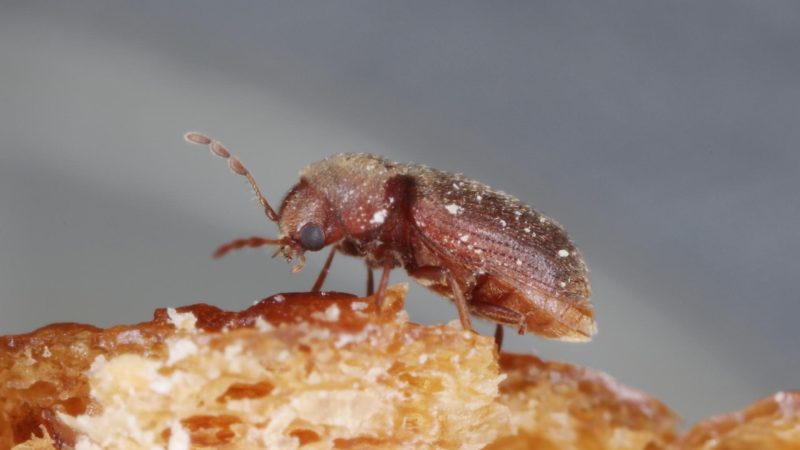
Drugstore beetles (Stegobium paniceum) are one of the most common stored product pests around the world, especially in tropical regions or in heated structures. Indoors, adults can be seen flying around while their larvae usually spend their entire life inside various stored products.
What Do Drugstore Beetles Look Like?
Also called the biscuit beetle or bread beetle, adult drugstore beetles are 2.25 to 3.5 millimeters long and are mostly brown to reddish-brown.
Their cylindrical body is covered with fine silky dense hairs, and their head seems to be invisible when viewed from above. On the other hand, biscuit beetle larvae are creamy white, about 4.8 millimeters long, and have a C-shaped body with very short hair.
Drugstore beetles look the same as cigarette beetles (Lasioderma serricorne), except that their antennae end in a 3-segmented club while the antennae of cigarette beetles are serrated.
What Do Drugstore Beetles Eat?
They mostly feed on pharmaceutical drugs, hence the name. But then, these small flying beetles also eat a wide variety of foods such as bread, chocolate, flour, and spices. They also eat non-food items including hair, leather, wool, museum specimens, and almost anything except steel.
Why Are There Drugstore Beetles in My House?
Drugstore beetles are very attracted to light at night, which is why you can find them in almost every place in your home, including the bathroom, bedroom, kitchen, pantries, and living room.
But in most cases, people accidentally bring them inside their homes when they buy infested food and store them for a long time. This is why you should always check your groceries or packages.
Are Drugstore Beetles Harmful to Humans?
Drugstore beetles are not harmful to humans, and they don’t carry diseases. They are also not known for biting people and are not considered dangerous. However, these wood borers are nuisance pests indoors and can cause severe damage to stored food products, artifacts, as well as shipping containers.
How Do I Get Rid of Drugstore Beetles in My House?
The best way to start is to find where larvae are or an area where an infestation is about to start. Once you do, here are some simple ways to get rid of drugstore beetles:
- Wrap heavily infested items inside a heavy plastic bag and throw them away.
- To kill all stages of drugstore beetles, place infested items in a freezer at 25°F (-3.8°C) for 7 days or at 36°F (2.2°C) for 16 days or more.
- For small quantities of infested materials, heat them in an oven at 190°F (87.8°C) for about an hour or at 120°F (48.8°C) for 16-24 hours.
- You may also use sticky traps such as Catchmaster Insect Trap & Monitors .
- To help prevent re-infestation, store your food in airtight glass, plastic, or metal containers.
- Buy food packages only those that are properly sealed and have no sign of damage.
2. Larder Beetle
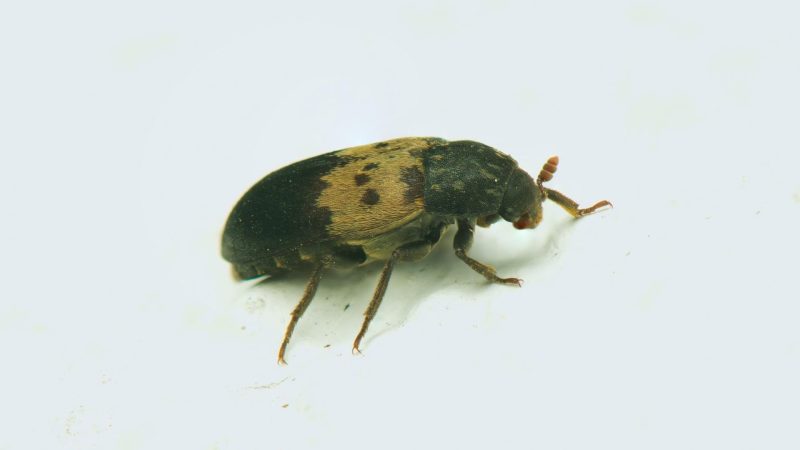
Larder beetles (Dermestes lardarius) are cosmopolitan insects, which means they are widely distributed as commercial and household pests around the world. These tiny beetles are commonly found in homes, mills, livestock facilities, museums, and any place that has a suitable food source.
What Do Larder Beetles Look Like?
Also called moisture beetles, adult larder beetles are ¼ to ⅓ inch long, with a dark brown or black oval body. They have a cream to the yellow band across the top of their wing covers with six dark-colored spots. The underside of their body is white and is covered with fine yellow hairs.
Larder beetle larvae are about ½ inch long, reddish to dark brown, and have a pair of curved spines (called urogomphi) on their last abdominal segment. Just like the adults, these worm-like larvae are also densely covered with hairs. Larder beetles are related to carpet beetles, but they don’t look the same.
What Do Larder Beetles Eat?
They feed on high-protein materials, including animal skin, furs, and feathers, as well as cheese, dry pet foods, cured meats, dried fish, dried museum specimens, dead insects, and small mammals or birds. Their larvae also dig into any commodity containing meat products.
Why Are There Larder Beetles in My House?
Larder beetles enter houses with neglected dead rodents and food pantries, hence the name. No wonder you can find them in kitchens, food storage areas, and attics.
Larvae can also be seen boring some holes in other soft materials such as insulation and books. They can also be present with boxelder bugs and cluster flies.
Are Larder Beetles Harmful to Humans?
Larder beetles are not known to bite humans, and they don’t carry diseases. Although they are not harmful and dangerous to public health, these small beetles in houses can damage stored food products and dry pet foods. In some cases, they may also bore into wood and wooden structures to seek shelter.
How Do I Get Rid of Larder Beetles in My House?
A few adult larder beetles inside your home may not lead to severe infestation. But because females can lay more than 100 eggs that can hatch in less than 12 days during ideal conditions, larvae will easily populate to infest your stored food.
Therefore, here are some ways to get rid of larder beetles at home:
- Check your attic and other hidden areas and dispose of dead rats or insects immediately.
- Larder beetles rarely fly, which means you can vacuum them easily.
- For infested items in small packages, place them in a freezer at 0°F (-17.7°C) for 3 to 4 days or heat them at 140°F (60°C) for half an hour.
- For cracks, crevices, and other small openings where larder beetles could be hiding, you may use permethrin insecticides such as Total Solutions Extinct Insecticide .
- To help prevent infestation, remove their food sources. Eliminate nests of birds, small rodents, and insects.
- Keep food products and dry pet food in tight bottles or cans.
3. Lesser Grain Borer
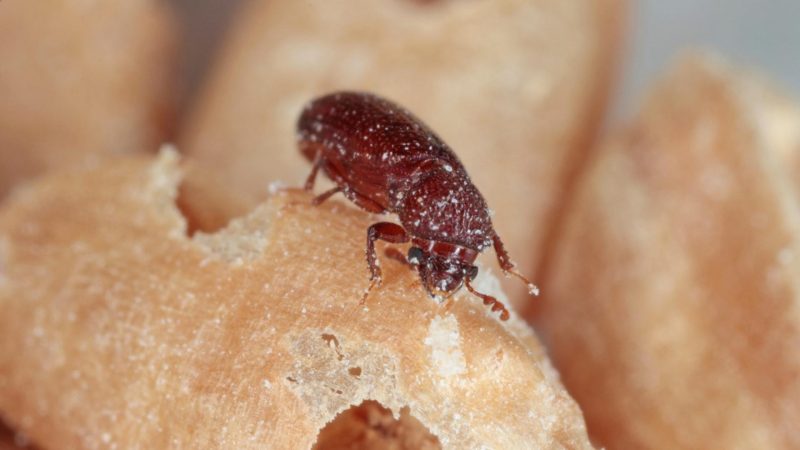
Lesser grain borers (Rhyzopertha Dominica) are serious pests of both whole stored coarse grain and cereal products, especially in tropical and temperate countries. Both the adults and larvae are cosmopolitan pests since larvae develop inside kernels and damage their internal contents.
What Do Lesser Grain Borers Look Like?
They are dark brown to black, 2 to 3 millimeters long, and have a slender and cylindrical body. These insects have a hood-shaped rounded neck and distinct rows of pits running all over their head and entire body. Their head is not visible from above and hidden under their prothorax.
What Do Lesser Grain Borers Eat?
As the name suggests, lesser grain borer adults and larvae mostly feed on grains. However, they also eat other foods such as beans, biscuits, cassava, corn, dried fruit, dried meat, fish, nuts, peanuts, spices, and wheat.
Adults are not strong fliers, but their jaws are very powerful, allowing them to bore into wood.
Why Are There Lesser Grain Borers in My House?
Aside from the common food items inside the house, lesser grain borers are also attracted to light. They may also be in your house once you accidentally bought infested food. Once inside, these flying beetles will bore holes into a whole, undamaged kernels and shelled grains, where they also lay eggs and live.
Are Lesser Grain Borers Harmful to Humans?
Lesser grain borers are not harmful to humans because they don’t bite or sting. They also don’t carry diseases and are not dangerous. However, they can cause severe damage to stored food. A serious infestation can also lead to a huge loss of money in cereal stores and warehouses.
How Do I Get Rid of Lesser Grain Borers in My House?
Lesser grain borers are also internal pests, and insecticides only kill pests that are exposed. Therefore, fumigation is usually required only in large amounts of grains.
Fortunately, a lesser grain borer infestation rarely occurs in houses. Meanwhile, here are some ways to get rid of lesser grain borers at home:
- Discard or throw away infested food, especially if they already produce unpleasant odors.
- Thoroughly vacuum grain storage boxes and cabinets.
- Apply Diatomaceous Earth (DE) on empty bins. Make you use only those labeled for grains. INSECTO Food Grade Diatomaceous Earth is one of them.
- If you need to use residual insecticides, choose those with cyfluthrin, such as . Read directions carefully before using.
Related: Borer Beetle Control: How To Get Rid of Borer Beetles in Trees?
4. Stag Beetle
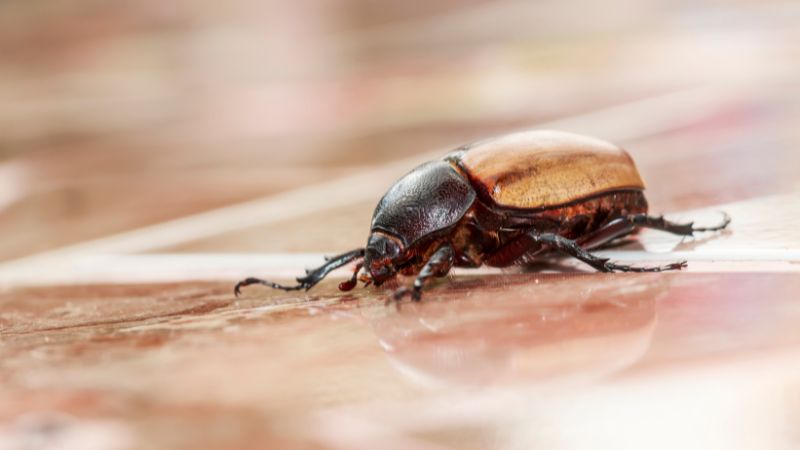
Stag beetles (Lucanidae spp.) are a family of flying beetles with about 1,050 known species globally, but only around 30 of those can be found in North America. One of the most common ones is the giant stag beetle (Lucanus elaphus), which usually flies in thick, moist forests but seldom indoors.
What Do Stag Beetles Look Like?
Depending on the species, stag beetles can grow between 2 and 4.5 inches long. They have dark brown to black bodies, hardened front wings (elytra), six long legs, and clubbed antennae. Their males have elongated and prominent mandibles, which they use in fighting with rival males and attracting females.
Females also have similar chewing parts but are smaller. Meanwhile, stag beetle larvae look like the grubs of Scarabaeidae, except that they are somehow larger.
Stag beetles are closely related to bess beetles (Passalidae spp.), although they differ in the structure of horn and antennae. In general, stag beetles look intimidating.
What Do Stag Beetles Eat?
Despite their bulky appearance, adult stag beetles are herbivores and feed on bark, honeydew, leaves, tree sap, and vegetation. Females usually lay eggs on decaying wood, where their larvae feed on the juices.
Why Are There Stag Beetles in My House?
Stag beetles are nocturnal bugs and are attracted to lights at night, especially during summer. They may be slow movers, but they can climb trees and enter homes through open doors and damaged window screens. Aside from shelter, this black flying beetle may also be searching for food and future mates.
Are Stag Beetles Harmful to Humans?
Stag beetles look scary due to their mandibles, but they are not actually harmful. They don’t transmit diseases to humans and pets. In very rare cases, they may pinch or bite humans in self-defense.
Nevertheless, their gigantic jaws are not powerful enough to injure human skin. In fact, stag beetles are considered beneficial insects, not pests, as they aid in the decomposition of dead wood.
How Do I Get Rid of Stag Beetles in My House?
So far, there is not much information about the conservation status of stag beetles in North America. And because stag beetles are not considered pests, here are some natural ways to get rid of them at home:
- Stag beetles don’t damage living wood, so it’s not necessary to kill them. Instead, wear safety gloves carefully pick them, and put them in the woods.
- Alternatively, you may also vacuum them slowly and get them out of your house.
- To prevent them from infesting your plants, spray soapy water near them.
- Remove heavily infested decaying wood, as well as unnecessary wood.
- Place homemade pitfall traps near the lights and use leaves as bait.
5. Stink Bug
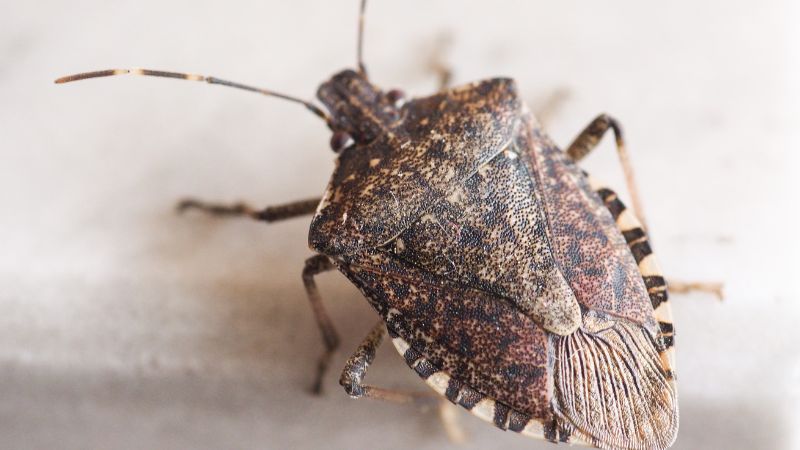
Stink bugs are nuisance pests for homeowners and have brought serious problems in the agricultural industry. There are several stink bug species found across North America but the recent and most common one is the Brown Marmorated Stink Bug (BMSB) (Halyomorpha halys).
What Do Stink Bugs Look Like?
As adults, brown marmorated stink bugs are about ⅝ inch long, marbled or mottled brown, with a shield-shaped body and smoothly rounded shoulders. They also have light bands on their antennae and dark bands on the edge of the abdomen, which make them unique as compared to other stink bugs.
As the name suggests, the brown marmorated stink bugs have stink glands that are underneath their thorax. They release foul odors to repel predators and when they are disturbed or crushed.
On the other hand, females lay white to pale green, barrel-shaped eggs. Newly hatched nymphs are about 2.4 millimeters long and have a yellow-red or orange abdomen.
What Do Stink Bugs Eat?
The stink bugs feed on more than 100 plant species, especially fruits and vegetables. This includes apple, beans, corn, cucumber, eggplant, okra, pear, pepper, soybean, squash, and tomato. When feeding, they use their straw-like mouthparts to pierce plants and then suck juices from them.
Why Are There Stink Bugs in My House?
Despite being notorious outdoor pests, especially in the summer, stink bugs will start entering houses during the colder months to look for shelter. They usually hitchhike on trucks, cars, trucks, and campers and are very likely to enter homes with bright lights. Also, they have a very superb flight capability.
Are Stink Bugs Harmful to Humans?
In general, stink bugs don’t bite or sting. They also don’t carry infectious diseases. Although they are not harmful to humans and they don’t damage structures, these flying beetles are nuisance pests, especially when they emit their unpleasant smell. Not to mention, they also significantly damage crops.
How Do I Get Rid of Stink Bugs in My House?
Stink bugs may hide in attics, basements, and other parts of your house during cold months. However, they will emerge in spring and early summer to go outside.
Therefore, you are likely to see lots of them during these seasons. To help you get rid of stink bugs at home, here are some of the things you can do:
- If possible, use a separate vacuum cleaner for dispatching stink bugs. Otherwise, your vacuum canister may acquire the smell of stink bugs over time.
- If you don’t have a dedicated vacuum cleaner, try using nylon stockings instead of vacuum bags. Contrary to myths, the odor of stink bugs does not attract other bugs.
- If there are only a few of them, you can spray soapy water directly on them, and they will drown soon.
- Place large pans filled with soap and water under the lights. Light traps kill stink bugs effectively during peak season.
- You may also use a spray, such as Terro Stink Bug Killer Aerosol Spray . This product is widely known for killing not only stink bugs, but also Asian lady beetles, boxelder bugs, and other insects.
- Use pheromone traps specifically for stink bugs, such as Bonide Bug Beater Indoor/Outdoor Stink Bug Trap . However, a 2-year study suggested that stink bug pheromone traps don’t work well in the winter. Instead, they are more effective in the spring or when daylight reaches 13.5 hours.
- To discourage stink bugs from entering your home, turn off unnecessary lights, especially at night.
- Seal all tiny holes, cracks, crevices, and other possible points of entry around your home.
Related: How to Get Rid of Stink Bugs? | Identification and Control Guide
Summary
As you probably know by now, not all beetles and bugs are pests. Also, using insecticides is sometimes not necessary in getting rid of them. The best way to drive them away is to understand their habitat and behavior. After all, this can also help you in preventing them from invading your home and creating damage.
List of Sources
Benson, E. P. (2021). Stag Beetles.
Cabrera, B. J. (2021). Drugstore beetle.
Hahn, J., & Kells, S. (2019). Larder beetles.
Ingels, C., & Varela, L. (2014). Brown Marmorated Stink Bug.
Koehler, P. G., & Pereira, R. M. (2018). Lesser Grain Borer, Rhyzopertha Dominica (Coleoptera, Bostrichidae).
- Bed Bug Surge 2025: How to Detect, Prevent, and Safely Eliminate Infestations in Top U.S. Cities - June 18, 2025
- Asian Needle Ants Invade US Homes: 2025 Guide to Identification, Risks, and Effective Control - June 11, 2025
- New World Screwworm Alert: How US Livestock Owners Can Prevent Outbreaks and Protect Herds [Summer 2025 Update] - June 8, 2025
